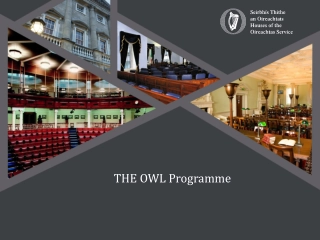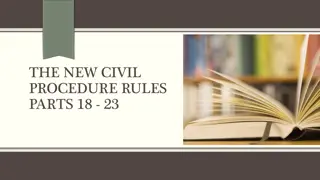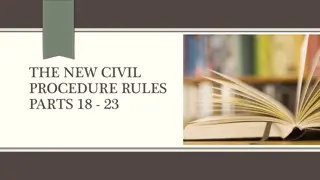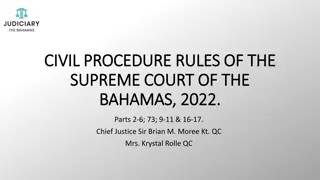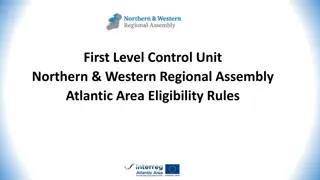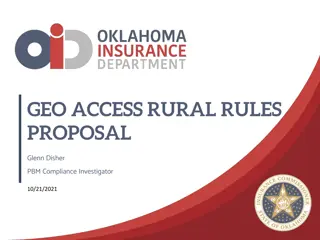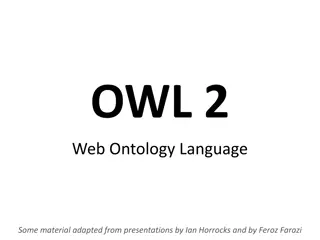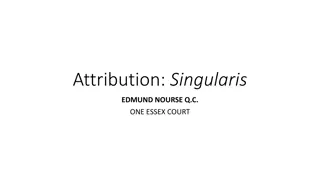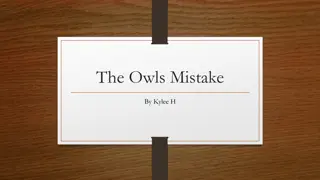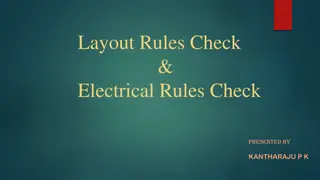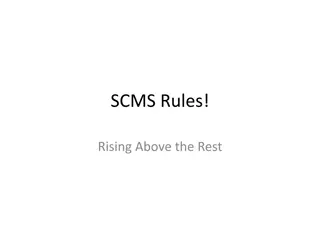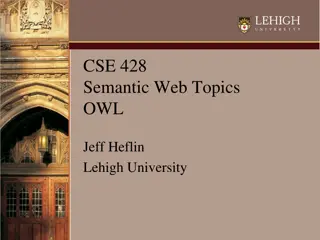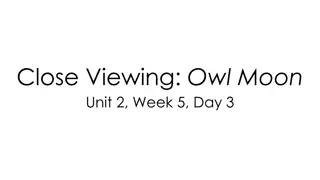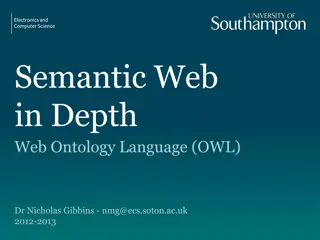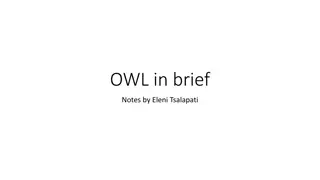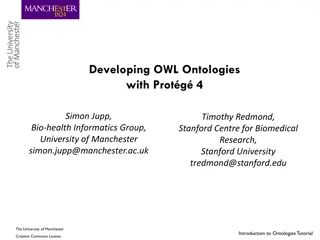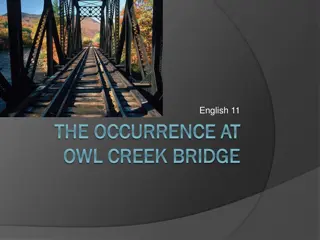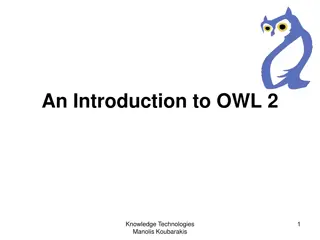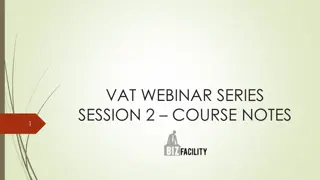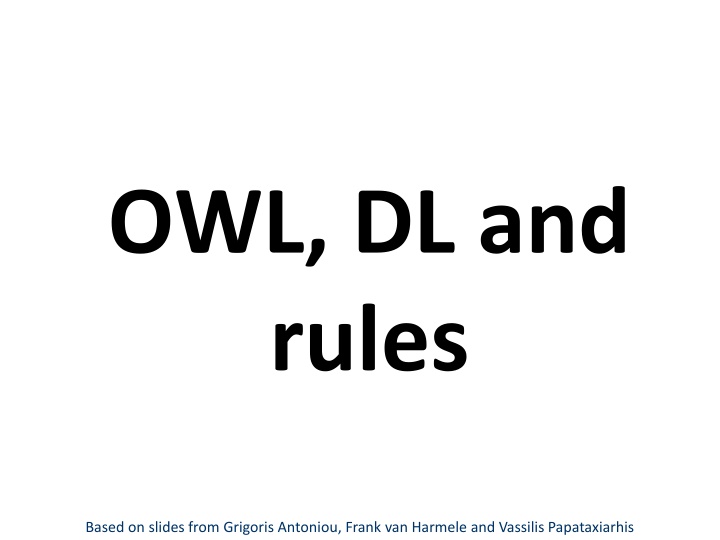
Semantic Web Logic: OWL, DL, and Rules
Explore the intersection of Semantic Web and logic through OWL, Description Logic (DL), and rule-based systems. Delve into the challenges and solutions in adding rules to OWL, different logic frameworks, and the importance of structure and rules in ontology development.
Download Presentation

Please find below an Image/Link to download the presentation.
The content on the website is provided AS IS for your information and personal use only. It may not be sold, licensed, or shared on other websites without obtaining consent from the author. If you encounter any issues during the download, it is possible that the publisher has removed the file from their server.
You are allowed to download the files provided on this website for personal or commercial use, subject to the condition that they are used lawfully. All files are the property of their respective owners.
The content on the website is provided AS IS for your information and personal use only. It may not be sold, licensed, or shared on other websites without obtaining consent from the author.
E N D
Presentation Transcript
OWL, DL and rules Based on slides from Grigoris Antoniou, Frank van Harmele and Vassilis Papataxiarhis
OWL and Rules Rule based systems are an important and useful way to represent and reason with knowledge Adding rules to OWL has proved to be fraught with problems We ll look at the underlying issues and several approaches SWRL: failed standard that has become widely used RIF: a successful standard that s not yet widely used
Semantic Web and Logic The Semantic Web is grounded in logic But what logic? OWL Full = Classical first order logic (FOL) OWL-DL = Description logic N3 rules ~= logic programming (LP) rules SWRL ~= DL + LP Other choices are possible, e.g., default logic, fuzzy logic, probabilistic logics, How do these fit together and what are the consequences
We need both structure and rules OWL s ontologies based on DL (and thus on FOL) - The Web is an open environment - Reusability / interoperability - An ontology is a model easy to understand Many rule systems based on logic programming - To achieve decidability, ontology languages don t offer the expressiveness we want. Rules do it well - Efficient reasoning support already exists - Rules are well-known and often more intuitive
Description Logics vs. Horn Logic Neither is a subset of the other Impossible in OWL DL: people who study and live in same city are local students Easily done with a a rule studiesAt(X,U), loc(U,L), lives(X,L) localStud(X) Impossible in horn rules: every person is either a man or a woman Easily done in OWL DL: :Person owl:disjointUnionOf (:Man :Woman).
Whats Horn clause logic Prolog and most logic -oriented rule languages use horn clause logic Defined by UCLA mathematician Alfred Horn Horn clauses: subset of FOL where every sentence is a disjunction of atoms where at most one is positive ~P V ~Q V R ~P V ~Q R Atoms: propositional variables (isMarried) or predicates (e.g., person(alice), mother(alice, ?x)) that can have variables
Alternate formulation as implications Horn clauses can be re-written using the implication operator ~P V ~Q V R P Q R (R true of both P and Q true) ~P V ~Q P Q (contradiction if both P and Q true)) R R (R is true) What we end up with is ~ pure prolog Single positive atom as the rule conclusion Conjunction of positive atoms as the rule antecedents (conditions) No not operator Atoms can be predicates (e.g., person(X), mother(X,Y), between(City, newYork, baltimore)
Prologs synax Prolog syntax is a bit different, putting the rule s conclusion first hasMother(?x, ?m) :- hasParent(?x, ?m), female(?m) . head = conclusion body = conjunction of conditions A fact is a rule w/o a body (i.e., no conditions) hasParent(john, tom). hasParent(john, mary). female(mary). Prolog proves queries by matching a fact, or a rule s conclusion and then proving each condition in the rule s body
We can relax this a bit Head can contain a conjunction of atoms P Q R is equivalent to P R and Q R Body can have disjunctions P R Q is equivalent to P R and P Q But somethings are just not allowed: No disjunction in head, e.g., man(?x) ; woman(?x) :- person(x) No logical negation operator, i.e. NOT man(?x) :- person(x), not(woman(x))
Where are the quantifiers? Quantifiers (forall, exists) are implicit Variables in rule head are universally quantified Variables only in rule body existentially quantified Example: IsParent(?x) :- hasChild(?x, ?y). isParent(X) hasChild(X,Y) forAll X: isParent(X) if Exisits Y: hasChild(X,Y) X isParent(X) Y hasChild(X,Y)
Facts & rule conclusions are definite Definite means not a disjunction Facts are rule with the trivial true condition Consider these true facts: P Q # either P or Q (or both) are true P R # if P is true, then R is true Q R # if Q is true, then R is true What can you conclude? Can this be expressed in horn logic?
Facts & rule conclusions are definite Consider these true facts where not is classical negation rather than negation as failure not(P) Q, not(Q) P # i.e. P Q P R, Q R Horn clause reasoners can t prove that either P or Q is necessarily true or false so can t show that R must be true
The Programming in Prolog Prolog = PROgramming in LOGic Prolog s procedural elements make it very useful, when used in moderation One element is it s unprovable operator, \+ \+ P succeeds if and only P cannot be proven Often called negation as failure Example: assume a person is unmarried if we don t know they are married Unmarried(?x) :- person(?x), \+ married(?x) .
Non-ground entailment (1) The LP-semantics defined in terms of minimal Herbrand model, i.e., sets of ground facts Because of this, LP horn clause reasoners can not derive rules, so that can not do general subsumption reasoning i.e., It can only reason about atomic facts to infer new facts It can t reason about rules and complex facts to create new rules
Non-ground entailment (2) A horn-clause reasoner can t do the following Given animal(?X) disease(?D) has(?X,?D) sickAnimal(?x) dog(?X) animal(?X) disease(rabies) Derive a new rule dog(?X), has(?X, rabies) sickAnimal(?X) Even though it follows from the underlying logic
Decidability The largest obstacle! Tradeoff between expressiveness and decidability Facing decidability issues from In LP: Finiteness of the domain In classical logic (and thus in DL ): combination of constructs Problem: Combination of simple DLs and Horn Logic are undecidable. (Levy & Rousset, 1998)
SWRL: Semantic Web Rule Language SWRL is the union of DL and horn logic + many built-in functions (e.g., for math) Submitted to W3C in 2004, but failed to become a recommendation (led to RIF) Problem: full SWRL specification leads to undecidability in reasoning SWRL is well specified and subsets are widely supported (e.g., in Pellet, HermiT) Based on OWL: rules use terms for OWL concepts (classes, properties, individuals, literals )
SWRL OWL classes are unary predicates, properties are binary ones sibling(?p,?s) ^ Man(?s) brother(?p,?s) As in Prolog, bulitins can be booleans or do a computation and unify the result to a variable swrlb:greaterThan(?age2, ?age1) # age2>age1 swrlb:subtract(?n1,?n2,?diff) # diff=n1-n2 SWRL predicates for OWL axioms and data tests differentFrom(?x, ?y), sameAs(?x, ?y), xsd:int(?x), [3, 4, 5](?x),
SWRL Built-Ins SWRL defines a set of built-in predicate that allow for comparisons, math evaluation, string operations and more See here for the complete list Examples Person(?p), hasAge(?p, ?age), swrlb:greaterThan(?age, 18) -> Adult(?p) Person(?p), bornOnDate(?p, ?date), xsd:date(?date), swrlb:date(?date, ?year, ?month, ?day, ?timezone) -> bornInYear(?p, ?year) Some reasoners (e.g., Pellet) allow you to define new built-ins in Java
Drawbacks of full SWRL Main source of complexity: arbitrary OWL expressions (e.g. restrictions) can appear in the head or body of a rule Adds significant expressive power to OWL, but causes undecidability there is no inference engine that draws exactly the same conclusions as the SWRL semantics
SWRL Sublanguages Challenge: identify sublanguages of SWRL with right balance between expressivity and computational viability A candidate OWL DL + DL-safe rules every variable must appear in a non- description logic atom in the rule body
DL-safe rules Standard reasoners support only DL-safe rules Rule variables bind only to known individuals (i.e., owl2 owl:NamedIndividual) Example :Vehicle(?v) ^ :Motor(?m) ^ :hasMotor(?v,?m) -> :MotorVehicle(?v) Where :Car = :Vehicle and some :hasMotor Motor :x a :Car Reasoner won t bind ?m to a motor since it is not a known individual Thus the rule cannot conclude MotorVehicle(:x)
Protg 5 had SWRLTab Add/edit rules and optionally run a separate rules engine
SWRL limitations SWRL rules do not support many useful features of of some rule-based systems Default reasoning Rule priorities Negation as failure (e.g., for closed-world semantics) Data structures Limitations led to RIF, Rule Interchange Format
Summary Horn logic is a subset of predicate logic that allows efficient reasoning, orthogonal to description logics Horn logic is the basis of monotonic rules DLP and SWRL are two important ways of combining OWL with Horn rules. DLP is essentially the intersection of OWL and Horn logic SWRL is a much richer language
Summary (2) Nonmonotonic rules are useful in situations where the available information is incomplete They are rules that may be overridden by contrary evidence Priorities are sometimes used to resolve some conflicts between rules

